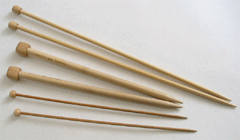A knitting needle is a long stick or rod used as a tool in the manufacture of hand knitted fabric. The needle is used to reach through a knitting stitch in order to snag a bight of yarn and pull a length back through the stitch to form a new loop at the top of the current wale of stitches. The simplest requirements of knitting needles are that they must be smooth, thin and long enough to reach through a stitch and strong enough not to break while manipulating the bight of yarn. Knitting needles, commonly used in pairs, are the only essential tools for hand knitting (Thomas, 1938; Hiatt, 1988).
Overview
 Knitting needles have also been called knitting sticks,
knitting pins, knitting wires, or simply
wires or rods (Rutt, 2003). Length and
thickness of the needles vary depending on the type of yarn
used (e.g., fine or thick) and the type of fabric to be
produced (e.g., firm or loose).
Knitting needles have also been called knitting sticks,
knitting pins, knitting wires, or simply
wires or rods (Rutt, 2003). Length and
thickness of the needles vary depending on the type of yarn
used (e.g., fine or thick) and the type of fabric to be
produced (e.g., firm or loose).
The most widely recognized form of knitting needle, probably invented in the mid 19th century, is usually called a straight needle. Straight needles are narrowed nearly to a point at one end and capped at the other with a knob or head (like the head of a straight pin), and are used almost exclusively for knitting flat two-dimensional fabrics like rectangles and squares. The needles are popular because the knob at the end of each needle prevents the stitches from inadvertently falling off the needles. Fictional depictions of knitting in movies, television programs, animation, and comic strips almost always show knitting done on straight needles. Both Wallace and Gromit and Monty Python, for example, show knitting being done with straight needles.
The oldest known knitting needles, still very much in use, are double-pointed needles. They are generally used to form tubular (coiled) fabrics such as socks and the bodies or sleeves of sweaters. As the name implies, double-pointed needles are tapered at both ends nearly to points. They are normally used in sets of four or five as depicted in a number of 14th century oil paintings, typically called Knitting Madonnas, depicting Mary knitting with double-pointed needles (Rutt, 2003). Typical 21st century double-pointed needles range from about 4 in. to 15 in. in length. Shorter needles are used for knitting socks and the fingers of gloves. Longer needles are used for nearly all other work, including sweaters, shawls and blankets.
Both tubular and flat knitting is also done on circular needles, today consisting of two pointed needles joined together by a flexible wire or length of nylon. Some manufacturers sell the two needles and the joining length of nylon separately. Different authorities, however, disagree on whether the needles should be thought of as a single needle or pair. Mary Thomas (1938) and June Hemmons Hiatt (1988) both imply that a circular needle (note the singular) consists of a pair needles (note the plural). Richard Rutt (2003), however, calls a circular needle (note the singular) a double-pointed needle (singular again), and so considers it a single needle. In any case, the two ends are used exactly like two needles, in the sense that the knitter holds one in each hand and knits as if having two.
Modern knitting needles are made of
bamboo, aluminum, steel,
wood, plastic, and
casein.
| Metric size (mm) | US size | UK / Canadian size |
|---|---|---|
| 2.0 | 0 | 14 |
| 2.25 | 1 | 13 |
| 2.75 | 2 | 12 |
| 3.0 | 11 | |
| 3.25 | 3 | 10 |
| 3.5 | 4 | |
| 3.75 | 5 | 9 |
| 4.0 | 6 | 8 |
| 4.5 | 7 | 7 |
| 5.0 | 8 | 6 |
| 5.5 | 9 | 5 |
| 6.0 | 10 | 4 |
| 6.5 | 10 |
3 |
| 7.0 | 2 | |
| 7.5 | 1 | |
| 8.0 | 11 | 0 |
| 9.0 | 13 | 00 |
| 10.0 | 15 | 000 |
| 12.0 | 17 | |
| 16.0 | 19 | |
| 19.0 | 35 | |
| 25.0 | 50 |
